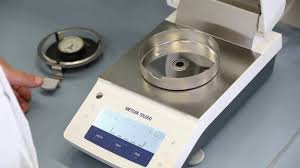Calibration of Halogen Moisture Analyzer

Calibration of Halogen Moisture Analyzer in Pharmaceuticals
1. Introduction
A Halogen Moisture Analyzer determines the moisture content of a sample by heating it with a halogen lamp and continuously measuring the weight loss until a constant mass is achieved.
Calibration ensures that both temperature and weighing accuracy are within specified limits to produce reliable results.
2. Objective
-
To verify the instrument’s weighing accuracy and temperature calibration.
-
To maintain compliance with GMP and pharmacopeial requirements.
-
To ensure consistent, accurate moisture content determination.
3. Types of Calibration
-
Weighing Calibration – Ensures the balance inside the moisture analyzer is accurate.
-
Temperature Calibration – Ensures the halogen heating element achieves the set temperature accurately.
4. Equipment & Materials
-
Certified calibration weights (Class E2/F1) for balance calibration
-
Certified temperature calibration kit (e.g., temperature sensor probe with traceable certificate)
-
Manufacturer’s calibration software or inbuilt calibration mode
-
Clean, dry moisture analyzer
5. Calibration Procedure
A. Weighing Calibration
-
Switch on the instrument and allow it to stabilize (warm-up period as per manufacturer).
-
Select balance calibration mode from the menu.
-
Place the certified calibration weight (e.g., 50 g) on the pan.
-
Confirm that the displayed weight matches the standard within tolerance limits.
-
Adjust or recalibrate as per the manufacturer’s instructions if outside tolerance.
B. Temperature Calibration
-
Connect the certified temperature probe to the analyzer.
-
Select temperature calibration in the instrument menu.
-
Set a test temperature (e.g., 100 °C).
-
Allow the instrument to heat and stabilize.
-
Compare the temperature reading on the certified probe to the set temperature.
-
Record the deviation. If outside the acceptable range (commonly ±2 °C), adjust as per manufacturer’s procedure.
6. Calibration Frequency
-
Weighing: Daily verification with internal/external calibration weights before use.
-
Temperature: Monthly or quarterly, depending on SOP and regulatory needs.
-
After repairs or suspected performance issues.
7. Documentation
-
Calibration date, time, and analyst name
-
Equipment ID and location
-
Calibration weight ID and certificate number
-
Set vs. observed temperature readings
-
Pass/fail result and corrective actions (if any)
-
Reviewer’s signature
8. Regulatory Reference
-
USP <41> (Balances)
-
ISO/IEC 17025 (Calibration standards)
-
ICH Q7/Q10 (Equipment calibration)
-
Manufacturer’s operating manual
Example Acceptance Statement:
“The halogen moisture analyzer ID: HMA-004 passed both weighing and temperature calibration as per SOP. It is fit for use in pharmaceutical QC moisture determination.”

